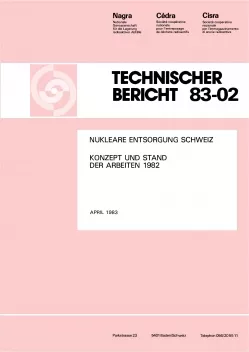
Rapport Technique NTB 83-02
Nukleare Entsorgung SchweizKonzept und Stand der Arbeiten 1982
The present report NTB 83-02 forms the first part of an intermediate status report on the work concerning nuclear waste management in Switzerland. The nuclear waste disposal concept is presented firstly, then the current state of NAGRA's research, development and project design work, which should lead to the future implementation of the concept, is reported on. The second volume of the intermediate status report (NTB 83-03), which is appearing at the same time, deals with the specific aspects of safety guarantees for final disposal.
The Swiss nuclear waste disposal concept is determined by legal requirements and by technical and economic factors.
At present there are four nuclear power plants in operation in Switzerland with a total generating capacity of about 2'000 MW(e), producing some 30 % of the nation's electricity and, thereby, giving rise every year to about 2 tonnes of radioactive matter, more than 99 % of which is contained in spent fuel. For final disposal planning a 6'000 MW(e) nuclear energy program was taken as a basis. Assuming 40 years as the operating period for each nuclear power plant, and assuming reprocessing of all the spent fuel elements, the total amount of waste arising works out at 1'000 m3 of high-level, 70'000 m3 of low- and medium-level, and 100'000 m3 of low-level wastes. The legal regulations require the permanent and safe disposal of all these wastes in final repositories.
Radioactive wastes differ from other special wastes in that, on one hand, their toxicity is overwhelmingly determined by the ionizing radiation emit ted, and, on the other hand, their radioactivity decays spontaneously in an exactly predictable manner. Ionizing radiation can be effectively shielded. Radioactive materials can become dangerous mainly if a sufficient amount gets into the biosphere and eventually into the human body. In this respect radioactive wastes are no different to chemical poisons – both must be isolated from the biosphere.
In contrast to chemical poisonous wastes which are usually stored in con trolled special waste repositories, the nuclear waste disposal concept provides a definitive disposal of radioactive wastes in final waste repositories in accordance with the legal requirements. Hence, a final waste repository is to be designed in such a way that control and surveillance measures can be dropped after its closure yet the population's protection and safety still be guaranteed. This should be achieved by the consequent application of the multiple safety barrier principle: Several containment and retention mechanisms are used one behind the other so that, should one safety barrier break down, others remain effective.
For a short time after their production radioactive wastes contain a high proportion of short-lived radionuclides and a relatively low proportion of long-lived radionuclides. After a certain time the situation is reversed: The short-lived radionuclides have then decayed and the long-lived ones dominate the waste's properties. Long-lived radionuclides are comparable to radioactive elements like uranium, thorium and radium, which occur everywhere in nature.
Accordingly the "lifetime" of the waste mixtures can be divided into two different phases:
I. At first the wastes are highly radio-toxic and for a limited period of time they must be kept away from the biosphere by complete containment. For high-level wastes this complete containment phase lasts about 1'000 years.
II. During the subsequent longer second phase of some tens of thousands of years the radio-toxicity of even high-level wastes falls below the level of various radioactive materials which occur in nature, e.g. uranium ores. The protective mechanisms of the final waste repositories then do not have to provide an absolute containment but have only to restrict the amount of wastes entering the biosphere to a non-dangerous level.
According to the Swiss nuclear waste disposal concept, complete containment in Phase I is already provided by the technical barriers. The necessary isolation in Phase II is achieved by technical and in addition by natural retention mechanisms. Therefore, suitable geological formations are chosen for final repositories. The sole medium which could transport the waste materials through the barriers is water. Both natural and technical retention mechanisms will therefore be selected with regard to their performance in preventing or slowing down this transport.
The in itself simple idea of several safety barriers leads to a widely diversified R + D program in which a large number of parameters must be determined – because quantitative prognoses about the safety of the final repositories are to be made. The status of this work and the outline of future projects are described comprehensively in the second part of this report.
NAGRA's current research and project design work is oriented toward the long term. The final repository for high-level wastes, for example, will not be needed until after the year 2020. Also the final repository for low‑ and medium-level wastes, which should be available as soon as possible, will scarcely be operational before the mid-90s for technical and procedural reasons For the nuclear power plants in operation or under construction, the Federal Department of Transport and Energy has, however, made the extension of operational licenses beyond 1985 subject to proof of the feasibility of safe final disposal of wastes. Hence NAGRA's short-term task: For this proof a guarantee project (Project "Gewähr") has to be worked out and has to be accepted by Government by 31 December 1985.
The last section of this report summarizes the status of NAGRA's work with regard to the guarantee project. It reveals that essential parts of data and knowledge necessary for the guarantee project are available and that programs to close the knowledge gaps are under way. One priority in NAGRA's current work is to evaluate existing data and to summarize them in one consistent safety study.
The work is aimed at drawing up this guarantee project and submitting it to the authorities by the end of 1984. Then the Government will be in a position to obtain experts' evaluation reports in 1985 and to decide on the project in question.
